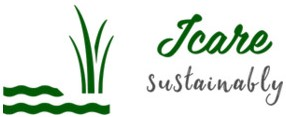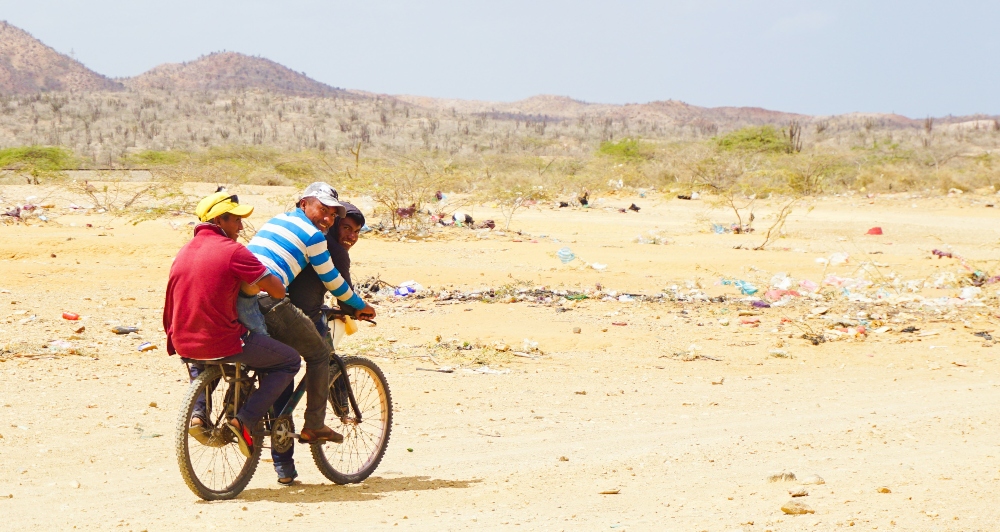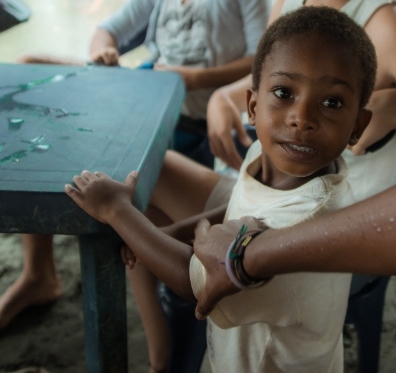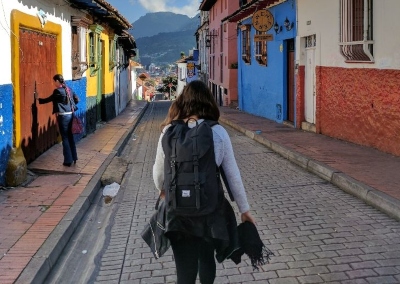
This article is written by Tatiana Gómez Tibasosa on behalf of Icare Sustainably International. Edited by Rianne Doller and Carolyne Nyarangi.
This article is part of a series where we look into the effects of the pandemic on Sustainable Development Goal 4, quality education for all. In previous articles, we looked at it from the perspective of Kenya, Trinidad and Tobago and we made a documentary. Icare is committed to working on the SDGs despite the Pandemic. These articles are part of our research to find out which projects are necessary.
Download the article here.
Table of Contents
Introduction
1: Shift in focus to study teachers’ initiatives in Colombia to mitigate effects of the pandemic
In previous articles we focused on what the government is doing, should do and can do to mitigate the effects of the pandemic on education for marginalized people. In this article, we shift the focus from the government to put three Colombian initiatives by teachers in the limelight. We shift the focus to show that overcoming the pandemic is not only in the government’s hands. We should also focus on the power of the people and the value of localized initiatives. Local people know best what fits in their specific situation and it puts less dependency on governments who don’t always respond quickly and effectively enough. One example of this need is regulations that both take into account hand-washing, together with the reality of water shortage.
The overwhelming and drastic changes caused by the COVID-19 pandemic has brought the possibility of rethinking and reconfiguring habits, customs and treatments (1). This is based on the measures and associated new ways of socializing that include, among others, different commute times, working from home and, of course, unimaginable challenges in the education field.
Our article will show that the switch in education is not unilateral, but location dependent. This by discussing some of the biggest challenges that the educational system has had in Colombia: a country that struggles with all its might to maintain a quality standard that is competitive with its neighbouring countries, despite the economic and infrastructural helplessness of the National government.
The pandemic exposed the realities of the involvement of the Colombian government in the living standard of the majority of the population. State aid is not available for a lot of people and all economic, educational and social success is through the people’s own efforts and interest. Some notable areas the government is lacking are: providing public services (electricity, natural gas, aqueduct, sewerage and internet) and social services (health, education, housing, transportation and recreation).
In this article, the effort of the Colombian government is compared with that of the people regarding their respective solutions to continue education during the pandemic.
1.1: In this article we will cover the following topics:
2.1: Context of Colombia
2.2 Action taken in Colombia to prevent the spread of Covid-19
3. How is education organized in rural Colombia?
3.1 Case-studies: impact Covid-measures on rural education
Case-study 1: When students can’t come to school, school comes to the children
Case study 2: Teachers take over the radio
Case-study 3: Education in shifts to save water
3.2: Take away case-studies
4. Conclusion: Lessons from the teachers during the pandemic
2: Colombian education is in quarantine together with the people
2.1: Context of Colombia
It is important to mention that education in Colombia cannot be defined in one singular way and is open to all kinds of interpretations and nuances. For instance, urban education is available when the family budget allows an underage to be educated in a public or private institution. From there comes the creation of social skills, job opportunities and general performance in the community.
On the other hand, more than 80% of the country is rural with limited networks to other areas. There are large protected areas, national parks, moors, mountains and deserts, among other ecosystems. This means that residents from the furthest areas from the cities are limited in their access to elementary and high school education, which also reduces the opportunity for them to reach higher education.
As shown above, whether people live in urban or rural areas, determines their access to education. Add to this the effects and the vicissitude of a pandemic that forced the world to stop abruptly and with little warning or time to prepare. The disease has claimed more than 1,034,000 lives to date since the first case was known in March 2020 (2).

2.2: Action taken in Colombia to prevent spread of Covid-19
Governments around the world were forced to take preventive measures in a matter of hours to contain spread. There were some sceptical governments who stated that it was only a political strategy of the countries with greater economic development. Other governmental bodies quickly banned crowds, motivated constant handwashing and the use of a face mask.
Additionally, without hesitation, some of the state budgets were aimed to improve hospitals, create tests to detect the virus, and purchase Intensive Care Units (ICUs) to provide care for as many people as possible. Consequently, education programs became less relevant in a time when education changed drastically because students and teachers don’t meet in person anymore but through a screen with virtual classes(3). These circumstances demand even greater creativity and innovation to work for all students for every region of Colombia. This article sheds light on this issue with the following three questions in mind:
- What happens in areas where virtual schooling is not an option (4)?
- How will the uneducated underage population, or the kids with special needs, get access to virtual learning?
- What are the impacts on education in a country like Colombia, for the rural regions specifically?
3: How is education organized in rural Colombia?
The small village schools generally have very few classrooms, a small sanitary unit (or bathrooms) and sometimes, a multifunctional field that is also used for community meetings on the weekend. The small children who attend these schools make long journeys through wooded areas or unpaved roads to get to class. In the afternoon they return to their homes where they help with planting, housekeeping or working. They learn from an early age how to be a peasant and the indigenous lifestyle which include harvesting, milking, or crops and farm animals caring.

3.1: Case-studies: impact Covid-measures on rural education
Once the pandemic “season” began and the national media announced the first prevention measures included the closure of roads, quarantine in the biggest cities and the mandatory social distancing that included the closure of events in bars, shopping malls and restaurants.
The main challenges in rural areas is a limited opportunity to buy and sell agricultural products, suspension of transport services to crowded areas to visit health centres, and of course, in-person classes were stopped throughout the country. The last point meant that boys and girls in the most remote areas would be left without receiving any classes or assistance unless they would think of some strategy together with the teachers that would allow them to continue learning while protecting themselves from the contagious COVID-19. We will discuss examples of some of those initiatives below.
Case-study 1: When students can’t come to school, school comes to the children
In some municipalities of Tolima department (Colombia), Rural Educational Institutions (REI) are located in the middle of dense forests and areas which are difficult to access by road. Some teachers from these schools have designed a series of guides that they printed and photocopied to take to each property where children reside who cannot go to educational centres directly (5).
The teachers in charge of their respective village school travelled by motorcycle to take these guides to each house. The journey is long and risky, but still the teachers chose to undertake it. This also enabled them to offer a brief explanation of the guide and its contents to the student and caretakers. At the end of the week they went to each house again to give feedback to the materials and to answer questions of the students.

Case study 2: Teachers take over the radio
Another example is from is examples are from municipalities in the district of Boyacá, Colombia. Boyacá is an expansive region with houses that are far from each other. This is because of large-scale farming of tubers and grazing lands. Teachers took over the local radio stations to teach classes to as many boys and girls possible. The only constraint was the students who couldn’t access the radio signal.
Some teachers even went further and offered to teach students through cell phone. This for students to not lose “the thread” of the learned topics in their respective subjects. The same method is used for exams and to record progress of the students.

Case-study 3: Education in shifts to save water

The Eastern region of Colombia is characterized by its wide plains and desert areas. In this area, mainly peasants and indigenous people reside. Here schooling in shifts was chosen as a solution to continue education of both the underage and adult population. Lessons were planned in time frames and in a weekly schedule. Students attend classes in small groups with their parents. This enabled everyone to keep distance and also to not run out of water in the sanitary units. With the schedule the students receive class at least three times a week. This is enough to maintain pre-pandemic academic levels.
Water is scarce in the Eastern region, so a solution had to be found that also diminishes pressure on the scarce resource, so the schools don’t run out of water or deplete the water for other uses.
3.2: Take away case-studies
Teachers from all over the country have created instruments, methodologies and tools to continue educating the learners. Each method is adapted to the students and regions’ specific challenges and needs. One thing is apparent: none of the solutions uses electronic learning despite the fact that it is offered as the best solution for schooling during the pandemic. There is a simple reason for that.
There is no internet coverage in most areas and students also lack access to computers or other electronic gadgets. If they have access, student and teachers lack the knowledge to use online schooling materials. Therefore, it is important to also focus on other alternative ways to continue education. We can learn from the spontaneous effort of the teachers if we don’t fixate on the one-case fits all solution of online learning.
Another takeaway from the case studies is that a one-solution fits all approach can cause more problems. If teachers in Eastern Colombia had allowed all students and parents to visit the school without a schedule it could have caused a water shortage.
4: Conclusion: Lessons from the teachers during the pandemic
Creativity is an endless resource used by teachers to ensure schooling continues. But, shouldn’t the National Government be the one who provides the resources for the improvement of the educational system in pandemic times? Because the alternatives provided by the educators from the three rural areas we discussed were all done without government involvement, be it by providing educational resources, knowledge or money.
Teachers need new and better educational instruments that allow them to strengthen their teaching methods, their technological skills and their didactic instruments to motivate and strengthen learning in each learner. The government should assist the teachers by providing those resources. Examples of resources they should provide are:
1. Safe Transportation
2. Well-Stocked Schools
3. Reliable Internet network
3. Access to Devices
And know-how to use them
This is also in the benefit of the government. When students from rural and remote areas have a means to continue their education the overall standard of education in Colombia increases. Consequently, this will create more competitive human beings with better social and economical skills. And well-educated people are vital to overcome the pandemic and to rebuild the world afterwards.

References
- “COVID – 19 is an infectious disease caused by the coronavirus that has been discovered recently (year 2020). Both this new virus and the disease and its causes were unknown before the outbreak broke out in Wuhan (China) in December 2019. Currently, COVID – 19 is a pandemic that affects the vast majority of countries around the world”. Taken from: https://www.who.int/es
- “By November 20, 2020, an approximate total of more than one million people have died globally as a result of COVID – 19”. Taken from: https://es.statista.com/estadisticas/1107719/covid19-numero-de-muertes-a-nivel-mundial-por-region/
- According to the records of the Ministry of Education in Colombia “in some capitals of the country, about 13,000 students from official (or public) schools were unreachable, since they do not appear in virtual classes neither did their parents come back to collect the academic guides that their teachers prepare ”. Viewed at: https://www.eltiempo.com/colombia/otras-ciudades/desercion-escolar-durante-la-pandemia-en-colombia-529536
- Gaviria (2020). “According to the National Administrative Department of Statistics (DANE), by the year 2019, 74% of the rural population lacks internet access […] On the other hand, in March 2020 it was revealed that about 56% of teachers do not have access to digital platforms in their educational environment and therefore their work is difficult in times of pandemic ”. Rural education. Consulted at: https://razonpublica.com/la-educacion-rural-problema-no-auelve-la-cone compactidad/
- Arias (2020). Rural education: the problem is not just connectivity. Taken from: https://razonpublica.com/la-educacion-rural-problema-no-apenas-la-conectividad/
Images:


Great piece
Thank you. Which part did you like most?
The first thing that came to my mind while going through the article was “A Worker Reads History”. This is a great initiative to recognize efforts made by teachers to help students continue their education. Highly appreciate the work.
It’s nicely articulated and really appreciated work. Education is definitely seeing a change.
Thanks. It is a great inspirational story.
Great reflection about the current situation. The education gap in Colombia must be reduced through better policies that involve government and educators on the same path.
Great suggestion. Do you have any ideas of good policy ideas to implement?
The challenges highlighted are also felt in countries where infrastructure is also dismal, but what I like about the article is that it has already pinpointed some possible remedies that can help address the problems of providing education to communities that have no internet connectivity and in remote areas. How I wish the government and private sector can find a way to address these inadequacies.
Thank you for your commentary. It is true there are similar problems in countries with bad infrastructure. Which body do you think is most suitable to make changes, the private sector, government or someone else?